HDR elevates your mobile event photography game by capturing a broader range of tones and colors, resulting in stunning images that truly reflect the atmosphere of any occasion. You'll capture details in both highlights and shadows, creating depth and dimensionality that standard photos often miss. HDR excels in challenging lighting conditions, balancing exposure in high-contrast scenes and enhancing color vibrancy. It's particularly effective for indoor events, outdoor gatherings, and low-light situations. With HDR, you can transform ordinary moments into rich, layered images that evoke emotions and accurately capture the essence of events. Mastering this technology will take your event photography to new heights.
Understanding HDR for Mobile Photography

Photographers often face challenges when capturing high-contrast scenes with mobile devices. This is where HDR (High Dynamic Range) comes into play. HDR is a technique that combines multiple exposures of the same scene to create a single image with a broader range of tones and details.
When you enable HDR on your smartphone, it takes several shots in quick succession at different exposure levels. These shots are then merged to produce a final image that balances highlights, shadows, and midtones. The result is a photo that more closely resembles what your eyes see in real life.
HDR is particularly useful in event photography, where lighting conditions can be unpredictable. It helps you capture details in both bright and dark areas of the scene, preventing overexposed skies or underexposed shadows.
However, it's important to use HDR judiciously. While it can enhance many scenes, it may not be suitable for subjects in motion or when you want to maintain strong contrast for artistic effect.
Most modern smartphones have built-in HDR modes, often with AI-assisted features that automatically detect when HDR would benefit your shot. By understanding how HDR works, you'll be better equipped to leverage this powerful tool in your mobile event photography.
Capturing Dynamic Range at Events
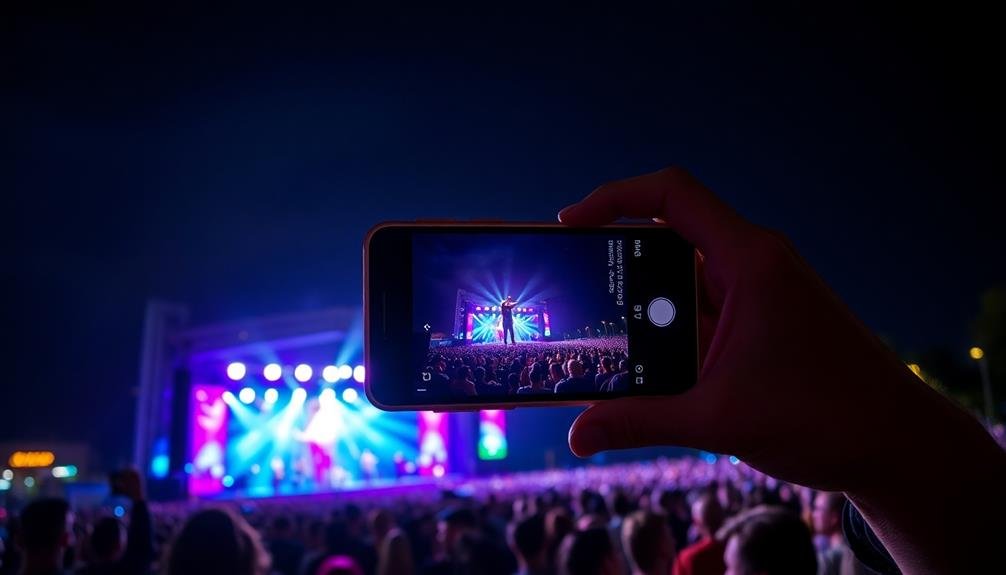
When you're shooting events with your mobile device, HDR can be a game-changer.
You'll be able to illuminate low-light scenes without losing details in the brighter areas, preserving both shadowy corners and highlight information.
Low-Light Scenes Illuminated
Low-light scenes at events present unique challenges for mobile photographers. You'll often encounter dimly lit venues, dark corners, or outdoor settings after sunset. HDR photography can be your secret weapon in these situations, allowing you to capture stunning images even in less-than-ideal lighting conditions.
When you activate HDR mode on your mobile device, it takes multiple exposures of the same scene. This technique helps illuminate dark areas without blowing out brighter parts of the image. You'll be able to reveal details in shadows while maintaining the ambiance of the event.
For example, at a wedding reception, you can capture the soft glow of candlelight on guests' faces while still showing the intricate details of table settings and decorations.
HDR also helps you balance artificial lighting sources common at events, such as stage lights, disco balls, or LED displays. You'll avoid harsh contrasts and uneven exposures, resulting in more balanced and professional-looking photos.
Remember to hold your phone steady or use a small tripod for best results, as HDR requires multiple shots to be combined effectively.
Highlight Details Preserved
Three common challenges in event photography are bright spotlights, reflective surfaces, and stark contrasts between light and dark areas. HDR technology on your mobile device tackles these issues head-on, preserving highlight details that would otherwise be lost.
When you're shooting a wedding reception or concert, HDR helps you capture the intricate details of a bride's white dress or a performer's sequined costume, even under harsh lighting. It prevents blown-out highlights, ensuring that you don't lose texture or depth in bright areas of your images.
HDR also excels at handling reflective surfaces like glassware, metallic decorations, or shiny dance floors. You'll be able to capture these elements without overexposure, maintaining their reflective qualities while still revealing their details.
Balanced Exposure Achieved
At events, capturing the full dynamic range of a scene can be challenging due to varying light conditions. With HDR, you'll achieve a balanced exposure that faithfully represents what your eyes see. This technique combines multiple exposures, ensuring that both bright and dark areas are properly exposed.
When you're shooting a wedding reception, for instance, HDR helps you capture the bride's white dress details without blowing out the highlights, while also retaining the subtle shadows in the groom's dark suit.
In outdoor events, you'll be able to showcase the vibrant sky and well-lit subjects in the foreground simultaneously.
HDR's balanced exposure is particularly useful for backlit situations. You won't have to choose between a properly exposed background or subject anymore. Instead, you'll get both in a single, well-balanced image.
This technique also helps in mixed lighting scenarios, like indoor venues with both artificial lighting and natural light from windows.
Balancing Highlights and Shadows
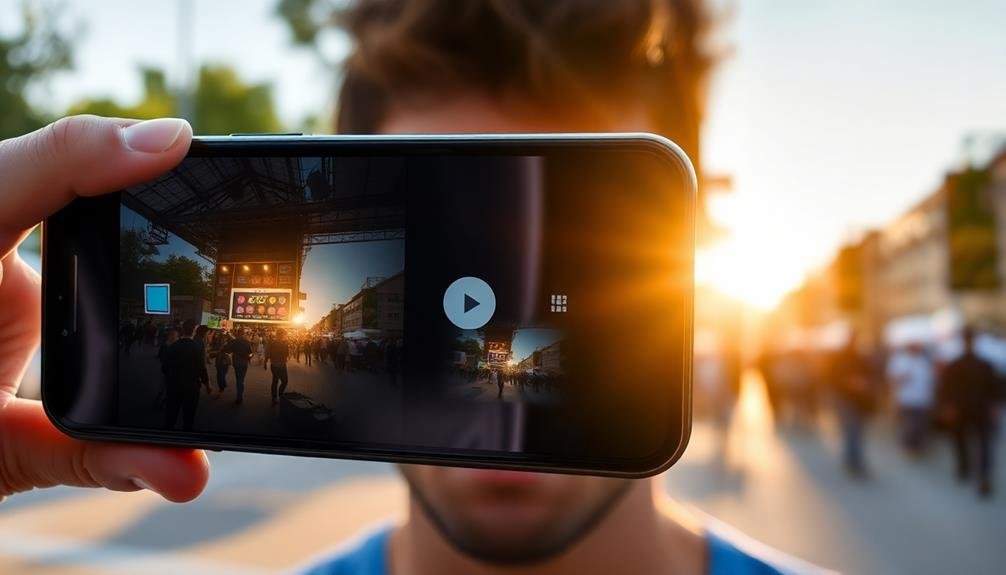
In spite of challenging lighting conditions, balancing highlights and shadows is essential for capturing stunning mobile event photography. HDR technology empowers you to achieve this balance effortlessly, ensuring every detail in your images is preserved. By combining multiple exposures, HDR brings out the best in both bright and dark areas of your shots.
When you're shooting events, you'll often encounter scenes with high contrast. A well-lit stage against a dark audience, or sunlit outdoor areas next to shadowy corners, can pose significant challenges.
HDR helps you overcome these obstacles by:
- Revealing details in shadowy areas without overexposing highlights
- Preserving vibrant colors across the entire image
- Reducing the need for flash, maintaining a natural ambiance
With HDR, you'll capture images that closely resemble what your eyes see, rather than settling for blown-out highlights or muddy shadows.
This technique allows you to create more engaging and realistic event photos that truly captivate your audience. By mastering HDR on your mobile device, you'll elevate your event photography game and produce professional-quality images that stand out from the crowd.
Enhancing Color and Detail

When you're capturing event moments with HDR on your mobile device, you'll notice a significant enhancement in color vibrancy and tonal range.
You can now capture subtle nuances in textures and details that might've been lost in standard photography.
Vibrant Hues and Tones
Through the power of HDR, mobile event photography can transform ordinary scenes into extraordinary visual experiences. When you capture events using HDR, you'll notice a significant boost in the vibrancy of hues and tones. This technique allows you to showcase the true colors of the event, from the deep blues of evening skies to the warm oranges of indoor lighting.
HDR enhances the overall color palette by:
- Balancing exposure across highlights and shadows
- Increasing the dynamic range of your images
- Preserving subtle color gradients that might otherwise be lost
You'll find that HDR brings out the richness in fabrics, decorations, and even skin tones, making your event photos more appealing and true to life.
It's particularly effective in challenging lighting conditions, such as outdoor events with harsh sunlight or dimly lit indoor venues. By using HDR, you'll capture the ambiance and mood of the event more accurately, ensuring that your photos reflect the vibrancy and energy of the occasion.
This technique helps you deliver images that not only document the event but also evoke the emotions and atmosphere experienced by attendees.
Capturing Subtle Nuances
Beyond enhancing vibrant hues, HDR excels at capturing subtle nuances in mobile event photography. It reveals details in shadows and highlights that your phone's standard camera might miss. You'll notice the intricate patterns on a wedding dress, the texture of a birthday cake's frosting, or the gentle play of light on guests' faces.
HDR's ability to capture a wider dynamic range means you won't lose information in high-contrast scenes. At outdoor events, you'll preserve both the sky's color and the details in shaded areas. Inside, you'll capture the ambiance of dimly lit venues without sacrificing the clarity of brighter elements.
This technique also enhances depth perception in your images. By bringing out subtle color gradations and tonal shifts, HDR creates a more three-dimensional feel. You'll notice improved definition between foreground and background elements, making your event photos more immersive.
HDR's nuanced approach to color and detail can make even mundane event moments look extraordinary. It breathes life into textures, fabrics, and surfaces, turning simple snapshots into rich, layered images that truly capture the essence of the event.
Preserving Shadow Information
HDR consistently excels at preserving shadow information in mobile event photography. When you're shooting events, you'll often encounter challenging lighting conditions with bright highlights and deep shadows.
HDR technology allows you to capture more detail in these shadowy areas, revealing textures and colors that would otherwise be lost in a standard photo. By combining multiple exposures, HDR guarantees that you don't sacrifice shadow detail for properly exposed highlights.
This is particularly useful when photographing:
- Indoor events with strong backlighting
- Outdoor gatherings during golden hour
- Stage performances with dramatic lighting
You'll notice that HDR photos retain more information in darker areas of the image, such as under tables, in corners of rooms, or in the folds of clothing. This enhanced shadow detail adds depth and dimensionality to your event photos, making them more engaging and true to life.
Moreover, preserving shadow information helps maintain the overall balance of your composition. It prevents the loss of important elements that might be lurking in darker areas, guaranteeing that every aspect of the event is captured accurately and beautifully.
Overcoming Challenging Lighting Conditions
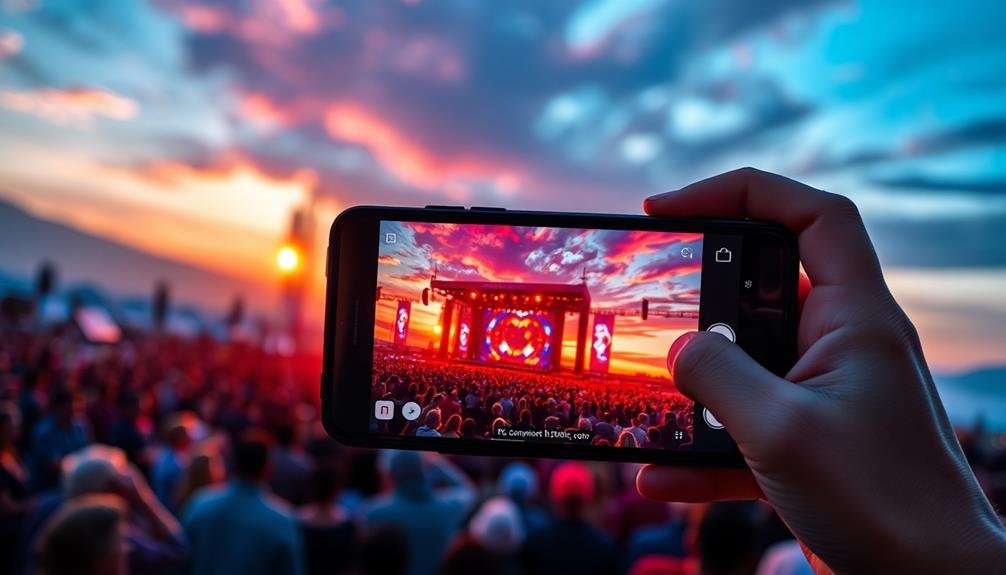
Mobile event photographers often run into tricky lighting situations that can make or break a shot. HDR can be your secret weapon in these scenarios, helping you capture stunning images even in challenging conditions.
When you're faced with high-contrast scenes, like a dimly lit reception hall with bright windows, HDR allows you to balance the exposure across the frame.
You'll find HDR particularly useful when shooting backlit subjects or dealing with harsh midday sun. It helps you retain details in both highlights and shadows, ensuring faces aren't lost in darkness or blown out by bright backgrounds.
In low-light situations, HDR can reduce noise and improve overall image quality by combining multiple exposures.
For indoor events with mixed lighting sources, HDR helps manage color temperature variations, producing more natural-looking results.
It's also invaluable when capturing outdoor scenes with dramatic skies, allowing you to preserve cloud detail without underexposing the foreground.
HDR Techniques for Different Occasions
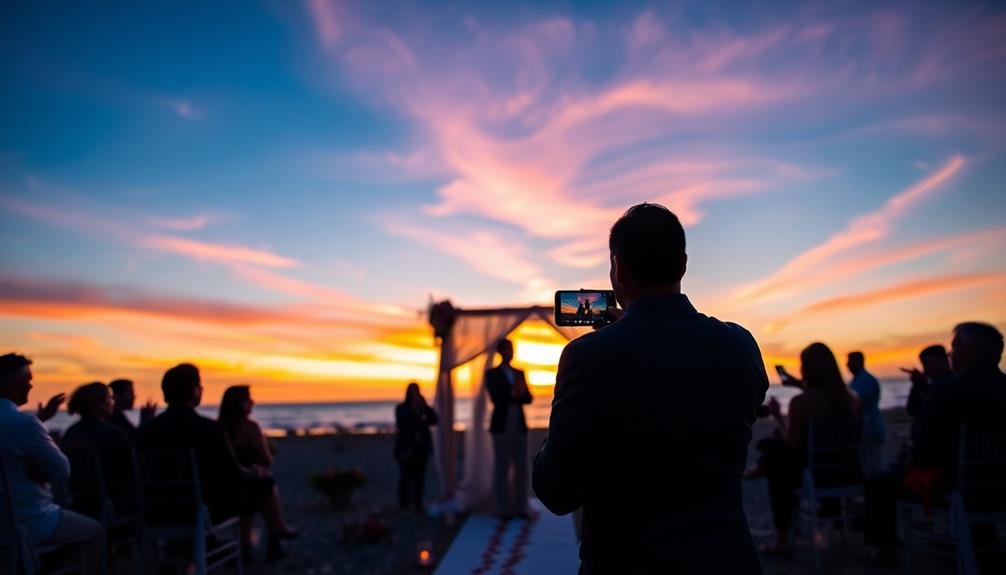
Different events call for unique HDR approaches to capture their essence effectively. For outdoor weddings, you'll want to balance the bright sky with shadowed areas, ensuring both the bride's white dress and the groom's dark suit are well-exposed.
At indoor concerts, HDR can help you capture the vibrant stage lighting while still revealing details in the crowd. For sporting events, use HDR to freeze action in varying light conditions, from sunny fields to shaded arenas.
When shooting corporate events, HDR can enhance the professional look of your images by balancing harsh overhead lighting with dimmer areas. For food photography at culinary events, HDR brings out textures and colors, making dishes look more appetizing.
In low-light situations like evening galas, HDR can help you capture the ambiance without relying too heavily on flash.
To make the most of HDR in event photography:
- Anticipate key moments and have your HDR mode ready
- Experiment with different HDR strengths to find the right balance
- Use a steady hand or tripod to avoid ghosting in HDR shots
Post-Processing HDR Event Photos
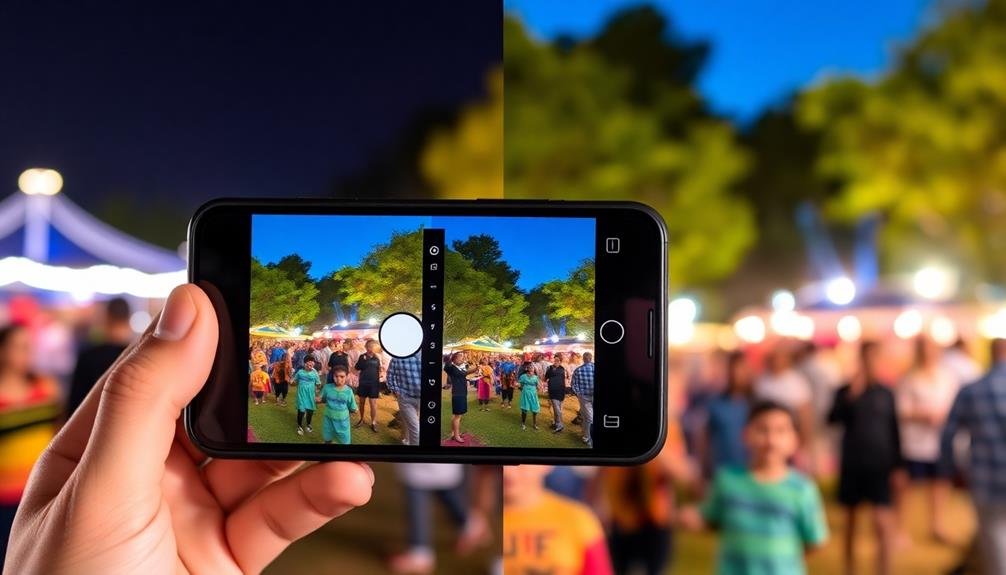
After you've captured your HDR event photos, post-processing is where the magic happens. Start by importing your images into your preferred editing software, such as Adobe Lightroom or Snapseed.
Adjust the exposure, highlights, and shadows to bring out the best balance in your HDR shots. Don't overdo it – aim for a natural look that enhances the event's atmosphere.
Next, fine-tune the color balance and saturation. Event lighting can be tricky, so make sure skin tones look natural and vibrant colors don't appear oversaturated.
Use selective adjustments to enhance specific areas of the image without affecting others.
Pay attention to noise reduction, especially in low-light shots. HDR can sometimes introduce artifacts, so use noise reduction tools carefully to maintain image quality.
Sharpen your photos judiciously to bring out details without creating an unnatural look.
Frequently Asked Questions
Can HDR Be Used for Capturing Fast-Moving Subjects at Events?
HDR isn't ideal for fast-moving subjects at events. You'll likely get motion blur or ghosting effects. Instead, use your camera's burst mode or a faster shutter speed to freeze action and capture crisp, clear images of moving subjects.
How Does HDR Affect Battery Life on Mobile Devices?
HDR can drain your battery faster because it takes multiple shots and processes them. You'll notice increased power consumption when using HDR frequently. To conserve battery, use HDR selectively and consider carrying a portable charger for long events.
Are There Any Privacy Concerns When Using HDR for Event Photography?
You shouldn't worry about privacy issues when using HDR for event photography. It doesn't capture any additional personal information. However, be mindful of people's consent when taking and sharing photos, regardless of the technology you're using.
What Are the Best Mobile Apps for HDR Event Photography?
You'll find several high-quality HDR apps for event photography on your mobile. Try Adobe Lightroom, ProCamera, or Snapseed for powerful editing tools. VSCO and Camera+ 2 also offer great HDR features to enhance your shots.
Can HDR Be Combined With Other Mobile Camera Features for Better Results?
Yes, you can combine HDR with other mobile camera features for enhanced results. Try pairing it with portrait mode, night mode, or manual settings. Experiment with exposure compensation and focus adjustments to maximize HDR's potential in your event photography.
In Summary
You've now accessed the power of HDR for your mobile event photography. By mastering this technique, you'll capture stunning images with balanced exposure, vibrant colors, and rich details. Don't let challenging lighting conditions hold you back anymore. Whether you're shooting weddings, concerts, or outdoor celebrations, HDR will elevate your photos to new heights. Experiment with different settings and post-processing techniques to find your unique style. Your event photography game has just reached a whole new level.

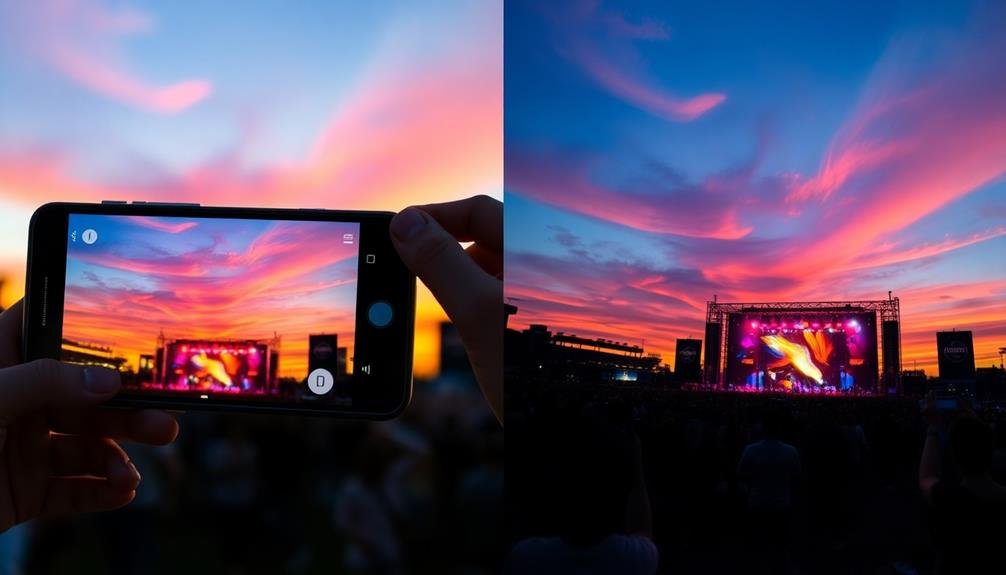



Leave a Reply